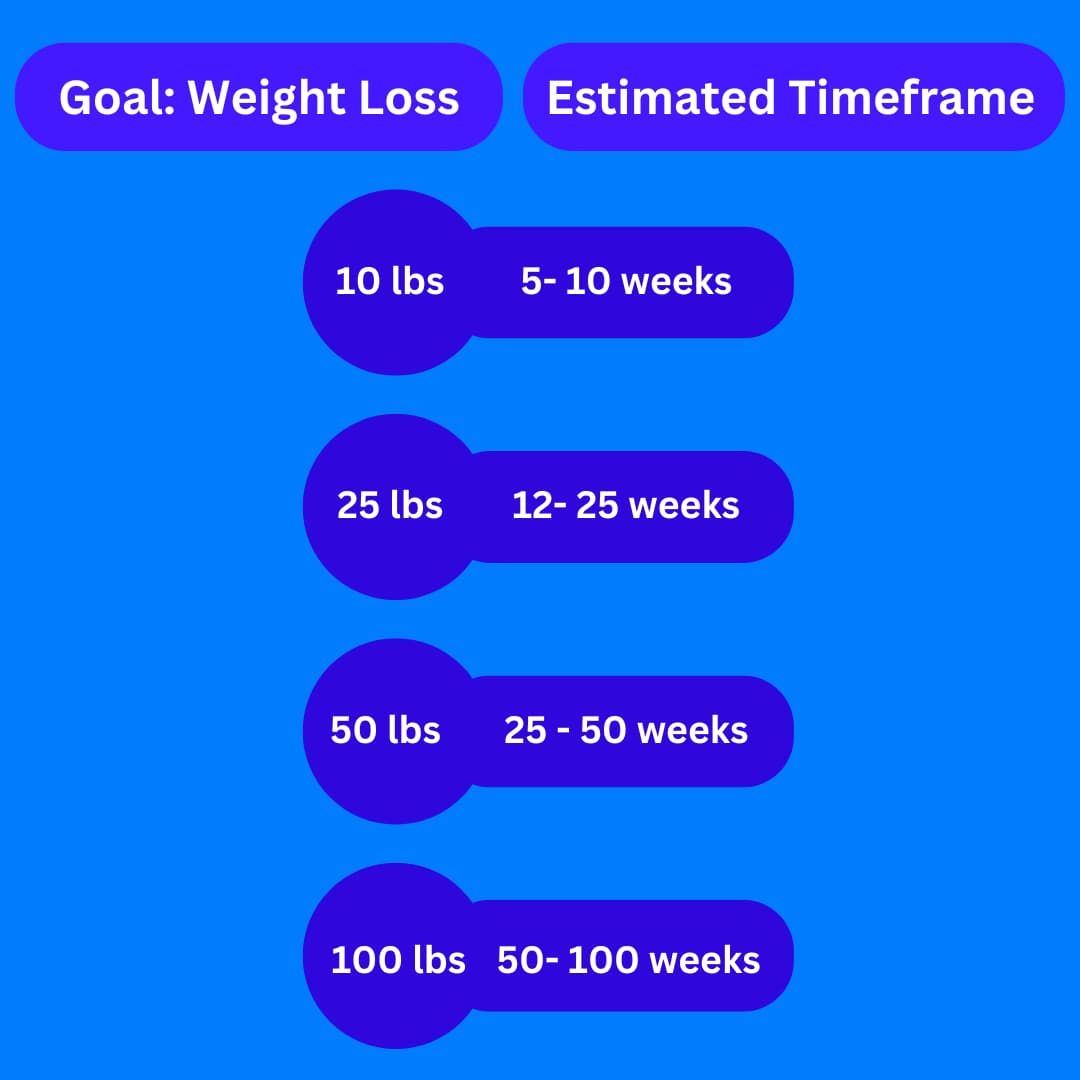
Losing a significant amount of weight is a journey that requires time, commitment, and a well-structured plan. Many individuals with a high BMI wonder how long it will take to achieve their desired weight loss goals. The answer varies depending on several factors, including starting weight, lifestyle changes, metabolic rate, and weight loss method.
Healthy Weight Loss Rates Explained
Healthcare professionals recommend a gradual weight loss rate of 1 to 2 pounds per week, considered safe and sustainable. This rate ensures that weight loss primarily comes from fat rather than muscle or water weight.
1 pound of fat equals approximately 3,500 calories.
- To lose 1 pound per week, you must create a calorie deficit of about 500 calories daily.
- Aiming for 2 pounds per week requires a daily deficit of 1,000 calories.
Using this guideline, a realistic timeline for significant weight loss might look like this:

Factors That Influence Weight Loss Timeline
Several factors impact how quickly you can lose weight:
1. Starting Weight
Individuals with a higher Body Mass Index (BMI) tend to experience more rapid initial weight loss than those with a lower BMI. This phenomenon can be attributed to several factors, including the body's metabolic response and the potential for more significant fat reserves to be mobilized during the early stages of weight loss.
In the beginning phases of a weight loss program, particularly in those with a higher BMI, the body may utilize stored energy more efficiently, leading to quicker reductions on the scale.
Moreover, during the first few weeks of weight loss efforts, individuals often observe more significant weight reductions mainly due to the loss of water weight. When a person changes their diet or exercise, the body can release stored glycogen, a form of carbohydrate storage that also holds water.
As glycogen is utilized for energy, the water that is associated with it is lost, resulting in a notable decrease in weight that doesn’t necessarily reflect fat loss. This initial phase may encourage individuals motivating them to continue their weight loss journey, even though subsequent weeks may yield slower or more gradual fat loss as the body adjusts to the new regimen.
2. Metabolic Rate
Age: Our metabolism can slow down as we age. There are hormonal changes and a natural decline in muscle mass, which can reduce our caloric needs. Younger individuals generally have a higher metabolic rate, enabling them to burn calories faster than older adults.
Genetics: Our genetic makeup can significantly impact our metabolism. Some people may inherit a faster metabolic rate from their parents, allowing them to burn calories more efficiently. This inherited trait can affect how fat is stored and how quickly calories are utilized during physical activities.
Muscle Mass: Muscle tissue burns more calories than fat tissue, even at rest. Therefore, individuals with higher muscle mass tend to have elevated metabolic rates. Strength training and building muscle can thus enhance the body's calorie-burning potential.
These factors interact to determine individual metabolic rates, influencing weight management and overall health decisions. Understanding them can help individuals tailor their fitness and nutritional plans to optimize their calorie expenditure.
3. Dietary Habits
A well-balanced, nutrient-dense diet emphasizing portion control and healthy food choices is crucial in promoting and accelerating weight loss. Such a diet includes a variety of foods rich in essential nutrients while relatively low in calories.
By focusing on the quality of food rather than just the quantity, individuals can enjoy diverse flavours and textures, which can help them feel satisfied and less deprived.
Portion control is crucial because it helps individuals manage their calorie intake. Eating appropriate portions allows for consuming a wider variety of foods, preventing boredom and enhancing diet adherence.
Furthermore, making healthier food choices, such as lean proteins, whole grains, fruits, and vegetables, ensures the body receives the necessary vitamins and minerals without excessive calories.
Ultimately, incorporating these principles into daily eating habits leads to sustainable weight loss and improved overall health, as it reduces body weight, enhances energy levels, and prevents chronic diseases.
4. Physical Activity
Combining strength training and cardiovascular exercises is a highly effective strategy for increasing overall calorie expenditure and promoting fat loss. Strength training, such as weightlifting or resistance exercises, helps build muscle mass.
Muscle tissue burns more calories at rest than fat tissue, which means the more muscle you have, the more calories your body burns throughout the day. Additionally, strength training can elevate your metabolism, leading to increased calorie burn even after the workout has ended.
On the other hand, cardio exercises, which include running, cycling, or swimming, primarily focus on increasing your heart rate and improving cardiovascular health. These exercises burn many calories during the activity and contribute to an overall caloric deficit, essential for losing weight.
You harness the benefits of both approaches by integrating strength training and cardio into your fitness routine. This combination boosts calorie burning during workouts and enhances recovery and muscle-building, improving body composition.
Such a balanced regime also helps reduce body fat while maintaining or increasing lean muscle mass, making it a comprehensive strategy for weight management and overall health improvement.
5. Medical Conditions
Conditions such as hypothyroidism and insulin resistance can significantly slow down weight loss by affecting the body's metabolism and hormone levels.
Hypothyroidism is when the thyroid gland does not produce enough thyroid hormones to regulate metabolism. When thyroid hormone levels are low, the body's metabolic rate decreases, reducing energy expenditure.
This means that even with a healthy diet and regular exercise, weight loss may be much harder to achieve because the body burns fewer calories than it would under normal conditions.
Insulin resistance, on the other hand, occurs when the body's cells become less responsive to insulin, a hormone that helps regulate blood sugar levels. As a result, the pancreas produces more insulin to compensate.
Elevated insulin levels can promote fat storage and hinder the body's ability to utilize fat as an energy source. Consequently, individuals with insulin resistance may find it challenging to lose weight, as their bodies are more inclined to store calories as fat rather than burn them for energy.
Both hypothyroidism and insulin resistance can create hurdles for weight loss by disrupting the body's natural metabolic and hormonal functions, making it essential for individuals with these conditions to work closely with healthcare professionals when managing their weight.
About Weight Loss Methods
1. Lifestyle Changes: Gradual but Sustainable
Making lifestyle changes involves adopting healthier habits over time. This can include restructuring your diet, increasing physical activity, and improving sleep quality. Gradual changes are more likely to be sustained in the long run, as they allow individuals to adjust to new routines without feeling overwhelmed. Such changes contribute to weight loss and promote well-being and a healthier lifestyle.
2. Medical Weight Loss Programs: Faster Results with Professional Supervision
Medical weight loss programs are structured and clinically supervised, often involving doctors and nutritionists. These programs may include personalized meal plans, prescription medications, and ongoing support to help individuals achieve their weight loss goals more rapidly than conventional methods.
The benefit of professional supervision ensures that these programs are tailored to the individual's health needs, making them a safer and more practical choice for those struggling to lose weight on their own.
3. Non-Surgical Options (e.g., Allurion Gastric Balloon): Significant Weight Loss in Months
Non-surgical options like the Allurion Gastric Balloon provide a less invasive alternative to traditional weight loss surgeries. This device is placed in the stomach and inflated to reduce the amount of food one can consume, thus promoting early satiety. Patients can expect significant weight loss within a few months of usage.
This option is attractive for individuals who want to lose weight without the risks associated with surgical procedures. It is often accompanied by counselling to help establish better eating habits for sustained weight management.
Understanding Short-Term vs. Long-Term Weight Loss Goals
While short-term goals provide motivation, focusing on long-term weight management is essential to prevent regaining the lost weight. A balanced diet, regular exercise, and behavioural changes are crucial for maintaining results.
1. Short-Term Goals
Losing 5-10% of body weight within the first 3-6 months is a significant and attainable health goal for many individuals, particularly those aiming to improve their overall well-being. This moderate weight loss can lead to profound changes in the body and is often a crucial step in managing conditions such as obesity, type 2 diabetes, and cardiovascular diseases.
When people lose 5-10% of their body weight, they may notice various health benefits. For instance, in individuals with type 2 diabetes, this weight reduction can contribute to better blood sugar control. Keeping blood sugar levels within a healthy range is vital to reducing complications related to diabetes.
Additionally, weight loss can positively influence cholesterol levels. As body weight decreases, many individuals experience improvements in their LDL (low-density lipoprotein) cholesterol levels, often referred to as 'bad' cholesterol. In contrast, their HDL (high-density lipoprotein) cholesterol levels, or 'good' cholesterol, may increase. This shift can lead to a lower risk of heart disease and stroke.
Furthermore, shedding excess weight often results in increased energy levels. This boost in energy can enhance daily activities and promote a more active lifestyle, which in turn can support further weight loss and improve physical and mental health overall.
With improved blood sugar, cholesterol levels, and enhanced energy, individuals may be more motivated to adopt healthier behaviours, contributing to sustained weight loss and overall wellness.
2. Long-Term Goals
Sustained weight loss over a year or more refers to the gradual and consistent reduction of body weight that a person maintains for an extended period, typically beyond 12 months. This kind of weight loss is often more beneficial and impactful than rapid weight loss, as it allows the body to adjust and can lead to lasting changes in lifestyle and health. It is often achieved through dietary changes, increased physical activity, and behavioural modifications that support long-term success.
Adopting lifelong healthy habits to prevent weight regain involves implementing and maintaining practices that promote overall well-being and energy balance. These habits may include regular physical exercise, mindful eating, portion control, and a balanced, nutrient-rich diet.
Additionally, it may encompass psychological strategies such as setting realistic goals, tracking progress, and seeking social support, which is crucial in ensuring that the weight loss achieved is maintained and contributes to a healthier lifestyle overall.
Achieving Weight Loss Milestones with Non-Surgical Options
The Allurion Gastric Balloon Program offers a safe, effective method to jumpstart weight loss for those seeking a structured approach without surgery. Patients can expect to lose 10-15% of their total body weight in approximately 16 weeks, making it a viable option for those needing guidance and support.
Common Challenges and How to Overcome Them
Weight loss is not always linear, and plateaus are a common part of the journey. Overcoming these challenges requires:
- Staying Consistent: Consistency is key to achieving long-term health and wellness goals. It's essential to adhere to your plan, even when you encounter obstacles or when progress seems to have plateaued.
By remaining steadfast in your commitment, you allow your body time to adapt to changes and position yourself for future success. Understand that progress may not always be linear; small steps taken regularly can lead to significant results over time.
- Adjusting Your Strategy: Regularly revisiting your calorie intake and exercise strategies is crucial for sustained progress. As your body adapts to your routine, your initial calorie needs and exercise regimen may no longer be practical.
Therefore, periodically reassessing these factors can help you tailor your approach to better meet your body’s requirements. This may involve increasing or decreasing your caloric intake or trying new forms of exercise to continue challenging your body and promoting improvements.
- Seeking Support: Engaging with a supportive network is vital for maintaining motivation on your wellness journey. Collaborating with healthcare providers and dietitians or participating in support groups can give you the guidance and encouragement you need.
These professionals can offer personalized advice and adjust your approach, while support groups foster a sense of community. Sharing experiences and setbacks with others can alleviate isolation and enhance your commitment to your health goals.
Remember
The timeline for losing significant weight depends on several factors, including lifestyle choices, metabolic health, and the selected weight loss method. A healthy and realistic goal is a steady loss of 1-2 pounds per week, which can significantly improve overall health. Consulting with a healthcare professional can help set realistic expectations and create a personalized plan tailored to your goals.










